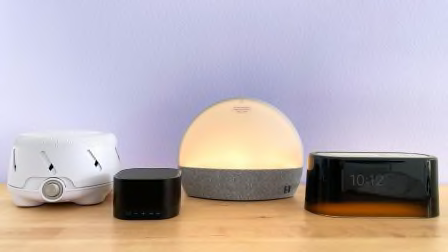How to Fall Asleep When Your Mind Won't Rest
Rein in racing thoughts with these calming, expert-backed strategies (no counting sheep required)
When you shop through retailer links on our site, we may earn affiliate commissions. 100% of the fees we collect are used to support our nonprofit mission. Learn more.

If you can’t fall asleep because you’re playing back all the drama from earlier in the day, you are not alone. I’m right there with you, along with 4 in 10 Americans, according to a nationally representative survey of 2,084 U.S. adults, conducted by Consumer Reports in October 2022. In fact, at 42 percent, “thoughts running through my mind, keeping me awake” was the most common sleep challenge Americans said they had experienced over the past 12 months.
The truth is, it’s not enough to get yourself physically ready for sleep—you need to settle in mentally too. No matter how well you wind down and cozy up in your sheets, your mind can take on a frenetic life of its own—rehashing cringey work conversations, freaking out over climate change, fretting over undone chores. Racing thoughts at night can create a hotbed of emotions that result in very physical repercussions.
When we’re anxious, our sympathetic nervous system activates the fight or flight response, says Maren Hyde-Nolan, PhD, a sleep psychologist at Henry Ford Health in Detroit. Our blood pressure rises, our heart rate quickens. Stress hormones coarse through our veins. How can anyone sleep with all this going on? It’s impossible. “You can’t simultaneously be anxious and calm your body down—and you can’t sleep when your body’s fight-or-flight response is activated,” Hyde-Nolan says.
Breathing Exercises to Calm Racing Thoughts
One important way to calm the racing thoughts in your brain is to focus on the body—specifically by slowing and lengthening your breath. You thereby temper the release of those stress-inducing hormones, so that the parasympathetic part of the nervous system can take hold, says Michelle Drerup, PsyD, director of behavioral sleep medicine at Cleveland Clinic. Your heart rate slows. Your blood pressure drops. As your body relaxes, your mind calms down, too, all of which help to ease your transition into sleep.
More Strategies to Tame Racing Thoughts
While paying attention to your breathing is important in and of itself, it often helps to incorporate mental exercise too. What works, Drerup says, is something that engages your brain enough to distract you from your racing thoughts, but not enough to keep you from sleeping.
Next time you find yourself staring at the ceiling, try one of the techniques below. Keep in mind, not everything will work all the time. So you might have to switch up your strategies from night to night, Drerup says.
Count backward. As you take slow, long breaths, count backward from 1,000. This requires just enough engagement to do, so you’re not easily pulled away by racing thoughts. If you lose track, don’t reprimand yourself. Simply go back to where you think you left off and continue the countdown.
Picture your favorite place. This exercise is a self-guided spin-off of the guided imagery technique popular in mindful meditation, a practice in which you focus your thoughts on an idea or an object. So be specific—a secluded beach in Cape Cod, Mass.; the library from your childhood; a coffee shop down the street.
Wherever your happy place is, imagine yourself in it and make a mental note of every detail, engaging all the senses: the blue of the sky, the texture of the sand, the scent of the sea, and so on. “You’re engaging all your neural pathways so other thoughts don’t come in,” Drerup says.
Do a body scan. You can progress from head to toe or vice versa. “Focus on one area of your body at a time, allowing it to fully relax before slowly moving on to the next area,” Hyde-Nolan says. (This technique works so well for me that I rarely make it to the opposite end.)
Listen to a bedtime story. I rolled my eyes when I first heard about this technique. This would never work! But for more than a year, I’ve turned to it again and again. You can find free stories on the YouTube channel of popular meditation apps (including Calm’s tour of New Zealand’s South Island with “Game of Thrones” actor Jerome Flynn, and Headspace’s visit to an antiques store on a rainy day with someone called Simon).
For a robust selection on your smartphone, though, you’ll have to pay for a membership, which I grudgingly did (but for me, it was worth it). Like the techniques above, listening to serene stories “can aid in both distracting your mind while simultaneously relaxing your body,” Hyde-Nolan says. I like that they often incorporate breathing exercises too.
How to Stop Racing Thoughts With the Help of Everyday Items
All the strategies we’ve mentioned can be done on your own, no instructor or apps are needed. Still, a little guidance can go a long way, especially if mindfulness techniques are new to you.
The most robust (and obvious) source of guidance comes from popular meditation apps, such as Calm, Headspace (my favorite), and Insight Timer. (All have free and premium options; as with all apps, make sure to read the privacy policy.) You also might want to take advantage of free online resources, like the exercises on Dartmouth University’s student wellness center site and UCLA Health.
For a more immersive experience, play any of these soothing sessions on a Bluetooth speaker, like the JBL Flip 5. To avoid waking a snoozing partner, consider a pair of wireless earbuds like the Apple AirPods Pro.
Beyond smartphones, fitness trackers and smartwatches are also enticing wearers to strap them on for rest and not just exercise. For instance, the Fitbit Charge 6 is designed to track all things related to wellness, including sleep and stress.
That said, to get the best wellness offerings, you’ll need to shell out additional money to access the Fitbit Premium app. Fortunately, you can sign up for a free 90-day trial—ample time to learn breathing exercises and even some meditation basics. Even if you choose not to renew, you’ll at least have some access to the Calm app (a Fitbit partner).
If you’re not keen on the stress-sensing capability (I already know I’m stressed!), then you might consider the less expensive Fitbit Inspire 3. All versions of the popular Apple Watch also incorporate mindfulness options. Read more about these devices in Best Fitness Trackers of 2024 and Best Smartwatches of 2024.
As you might expect from digital assistants that do just about everything, they can help you focus on your breath and quiet the mind too. Take the Google Nest Hub (2nd Gen) Smart Speaker. Simply say: “Hey Google, start a meditation,” and it will serve up a small range of options, including a body scan (courtesy of the Calm app) with breathing guidance. You can also call up YouTube content (such as the bedtime stories from Calm and Headspace, mentioned earlier) or use the screen as a sunrise alarm clock. Set on Sleep Sensing mode, it can even track your sleep, thanks to built-in sensors that detect every breath and movement. (Learn more about how the Google Nest Hub works in our in-home review.)
If letting a digital assistant track your sleep creeps you out, or if you just don’t want a screen (and a camera) in the bedroom, there are other options, says Allen St. John, who writes about technology, including sleep tech, for CR. You might just go with an audio-only speaker, such as the Google Nest Audio, which delivers meditations with the same command, or the Alexa-powered Amazon Echo, for which you can purchase third-party meditation apps. Note: If you want to bring a smart speaker or smart screen into your bedroom, make sure you know how to turn off the microphone and/or the camera to help protect your privacy, St. John says. (See the best smart speakers.)
Many sunrise alarm clocks also have great bedtime features. For instance, you can set the iHome Zenergy Sunrise Bedside Therapy Machine ($60 at Amazon, Best Buy, and Walmart) to “sunset mode” to calm your room with a warm glow. But it also has a feature that coaches you through a 4-7-8 breathing exercise. At bedtime, choose from 15 soothing sounds to mask annoying ambient noises and drift off to sleep. The controls aren’t the most intuitive, but once you get the hang of it, the Zenergy just may become the sleep assistant you never knew you needed.
Tips for Better Sleep
It's often what you do long before bedtime that will help bring on a great night's rest.




















